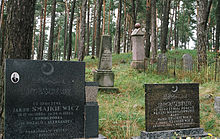Lipka Tatars



The Lipka Tatars ( Lipka is Crimean Tatar for Lithuania ), also known as the Belarusian Tatars , Lithuanian Tatars or Polish Tatars , are a group of Tatars who settled on the territory of what was then the Grand Duchy of Lithuania at the beginning of the 14th century .
history
The first Tatars came as refugees, who, contrary to the advancing Islamization, continued to cling to the original shamanism and sought refuge with the not yet Christianized Lithuanians . At the end of the 14th century, another wave of Tatars, this time of Muslim faith, immigrated to the Grand Duchy at the invitation of Grand Duke Vytautas . This second wave initially settled in the area around the cities of Vilnius , Trakai , Hrodna and Kaunas and spread from there over the entire area of the Grand Duchy and later of the unified Poland-Lithuania in the following centuries . This area is now roughly occupied by the states of Lithuania, Poland and Belarus . From the beginning, the Tatars in Lithuania were known as the Lipka Tatars. While they maintained their Muslim faith, the Lipka Tatars were loyal to their later Christian homeland, Poland-Lithuania, and often provided troops in the event of war. Since the Battle of Tannenberg at the latest, units of light Tatar cavalry fought in almost all major military conflicts in Lithuania and Poland.
origin
The origin of the Lipka Tatars can be traced back to the successor empires of the Mongol Empire , the Blue and Golden Horde as well as the Crimean Khanate and the Kazan Khanate . Shortly after their settlement, they assumed the role of a higher military caste, but later also made a reputation for themselves as skilled craftsmen, farmers and horse breeders.
The first Tatars settled in the Vilnius region in the 14th century . In the 17th century, Tatars from the Crimean peninsula ( Crimean Tatars ) fought against the Ottomans on the side of the aristocratic republic of Poland-Lithuania . King Jan Sobieski did not have sufficient financial means to pay war wages to the Tatars for their services. So he compensated them by giving them land in Podlachia , more precisely the places Kruszyniany , Nietupa , Łużany and Poniatowicze . As a result, the first 45 Tatar families immigrated to this region in 1679. Tatars did not pay taxes, but each family had to provide a mounted soldier for the army. The men were allowed to marry a local woman and raise their children as Muslims. In addition, the Tatars received the names and rights of nobles , which is why many today have Slavic surnames.
language
The Lipka Tatars adopted the Ruthenian language , later the Belarusian language. However, they used the Arabic script ( Belarusian Arabic alphabet ) until the 1930s . In addition to the adoption of Slavic surnames, other Tatar names were only Polonized and still show the original origin today, for example: Abakanowicz, Achmatowicz, Chazbijewicz and Musatowicz.
Current situation
In the Podlaskie about 3,000 Tatars live. There are some Muslim communities, especially in rural areas, for example in Kruszyniany, where there is a mosque . There followers report that every now and then there are riots against institutions of the congregations, but that overall they get on well with their Catholic neighbors. About 6000 Lipka Tatars live in Belarus and about 4000 Lipka Tatars in Lithuania (especially around the region of the capital Vilnius ).
According to Deutschlandfunk , most of the Lipka Tatars should first and foremost describe themselves as Poles and only then as Muslims. Only 500 still consider themselves “pure” Tatars instead of Poles and speak a Belarusian dialect .
Personalities
- Charles Bronson's father Walter Buchinsky was an American immigrant of Lipka-Tatar descent
- Jerzy Edigey (1912–1983), Polish writer
- Jakub Szynkiewicz (1884–1966), Polish mufti
- Magdalena Abakanowicz (1930–2017), Polish sculptor and textile artist
- Osman Achmatowicz (1899–1988), Polish chemist
See also
literature
- Jurgita Šiaučiūnaitė-Verbickienė: The Tatars. In: Grigorijus Potašenko (Ed.): The Peoples of the Grand Duchy of Lithuania. Vilnius 2002, pp. 73-82.
Web links
- Entry: The Lithuanian Tatars. In: The Peoples of the Red Book. 1993, accessed July 7, 2018.
Individual evidence
- ↑ a b Alexander Hertel: Islam: "We are Poles first, then Muslims". In: Deutschlandfunk. March 3, 2016, accessed July 7, 2018.
- ↑ Harvard Encyclopedia of American Ethnic Groups: Polish or Lithuanian Tartars. Harvard University Press, p. 990.
- ↑ Selim Mirza-Juszeński Chazbijewicz: Szlachta tatarska w Rzeczypospolitej. (Tartar Nobility in the Polish-Lithuanian Commonwealth) Verbum Nobile No. 2, 1993, Sopot, Poland.

